Yanjing Catholic Church in Tibet – Tibet Travel Information by Explore Tibet
In the east of Tibet, in a small valley to the west of the Jinsha River, lies one building that is unique in Tibet Autonomous Region. Whitewashed against the sun, the building gleams under a clear blue sky as every morning people file inside. This is not an ordinary building, however. The stunning interior decorations and the two huge crosses fixed to the outer walls tell visitors that they have come across the only Catholic church in Tibet.
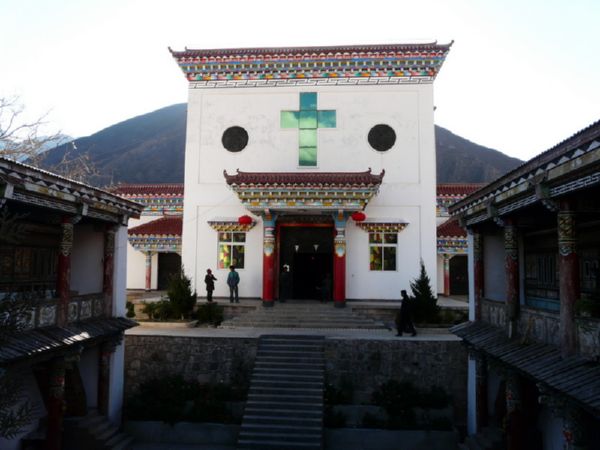
Yanjing Catholic Church
The village of Upper Yanjing, which boasts a population of over 600 Catholics out of its 900 residents, is the only place in Tibet where you can still find a Catholic church, and it is a small oasis of Christianity within this very Buddhist region. Co-existing in harmony with the local Buddhist religion for more than 150 years, the church lies on the top of a small hill in this quiet little village, where marriages regularly take place between Catholic and Buddhist.
Table of Contents
History of the church in Tibet
The church was one of several founded in Tibet in the mid-19th century and is the only one that has survived in this bastion of Buddhism. In 1865, Father Felix Biet and Father Auguste Desgodins, two French Catholic priests, made the journey to Tibet as missionaries. Traveling with 35 of their brethren, the two newly-ordained priests pushed into Tibet from China, starting missions and churches along the route they took from southern China, including the historic church in Yanmen of Yunnan province.
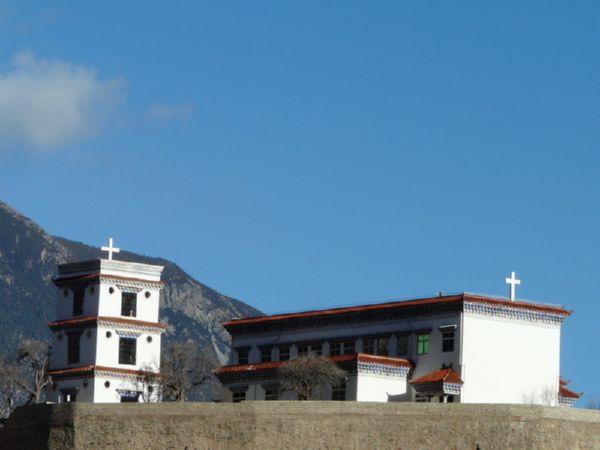
After months of travel in Tibet, the priests finally ended up in Yanjing, also known as Yerkalo, in Markham County. After buying the land where the church now stands from the local lamas, the priests began the work of building the church and bringing in their flock.
Getting established in Tibet in the middle of the 19th century was hard, and there were often clashes between the church and the local lamaseries. In the late 1940s, after Father Felix’s successor, Father Maurice Tourney, was killed in one such clash, the church was taken over by Lamas, and remained in Buddhist hands until 1951.
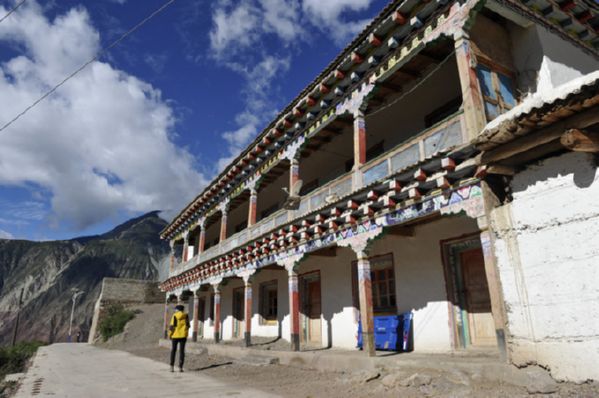
Throughout the Cultural Revolution, the church was a school for primary and middle-school students in the area, and the expansion damaged much of the original roof of the church. It was not until the late 1980s that the church saw its renovation and was rebuilt along the lines of the original church with aid from government funds.

Now, the church is run by a Tibetan priest, Father Laurent, who has the largest number of parishioners of any church in China. Formerly known by his Tibetan name, Lu Rendi, he runs the church with the help of two Tibetan Catholic nuns, and the church teaches tolerance of other religions and beliefs. With more than 600 Catholics in the village itself, this number swells to almost 800 with the addition of Tibetan Catholics that live outside the village in the surrounding hills and valleys.
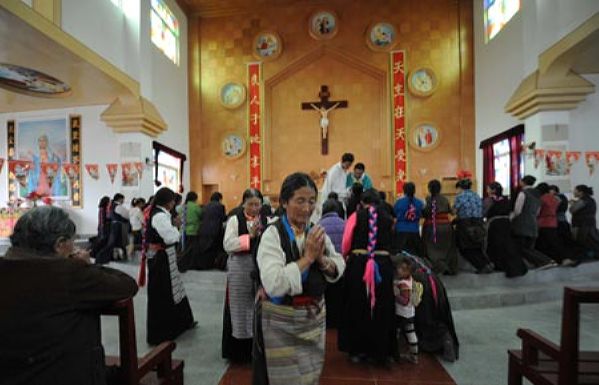
Local residents in the village that follow the Catholic faith are christened with Christian names that they bear throughout their lives and are buried according to the traditional Catholic rituals. Although marriages are not performed in the church (couples have to be married in a standard Chinese civil ceremony), the children of mixed religion couples are free to choose their own religion.
Unique Tibetan Christian Faith
Catholicism and Christianity in Tibet are unique in many ways. Not only do Tibetan Christians know the Bible, since it has been translated into Tibetan, but the Catholic faith has taken on several of the Tibetan Buddhist customs and features. Much of this crossover has been due to the influence of the Catholic Fathers of Yanjing, and has been only one way, with no features of Christianity being adopted by the local Buddhists.
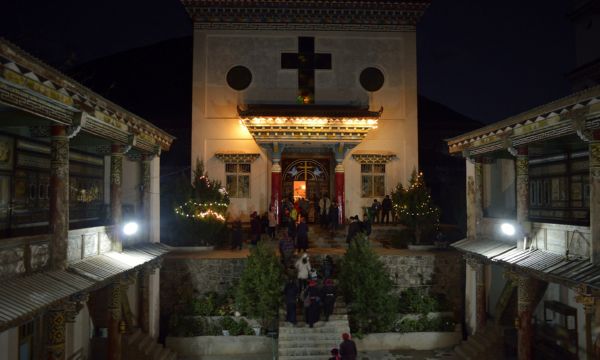
The first thing that has translated into Catholicism is the Tibetan New Year, or Losar. Catholics in Tibet still follow the traditions of Losar but recite passages from the Christian bible instead of the holy Buddhist scriptures. They still present the traditional hada, the long Tibetan silk scarves, as a greeting to others, as well as placing the hada on the statues of the Virgin Mary. The clergy, according to Father Laurent, also wear traditional Tibetan costumes instead of the usual Catholic robes worn by priests and nuns.
There is also a crossover of celebrations in the area, between the church and the local lamaseries. Lamas and Tibetan Buddhists are invited to Christian celebrations throughout the year, such as Easter and Christmas, and in return, the lamas invite the Christian population to attend the many Buddhist celebrations and festivals.
Christianity in Tibet
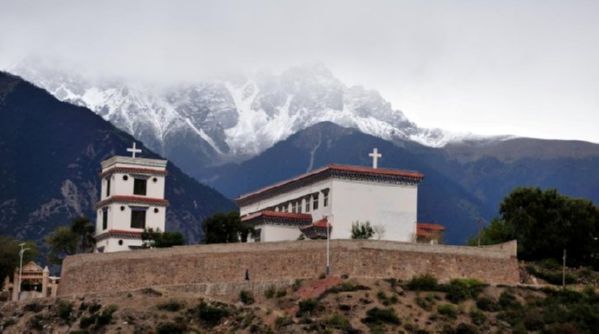
The first Christians to enter Tibet were the Nestorians, a branch of the Christian church that is better known now as the Church of the East, in the late 13th century. Christian missionaries from Portugal first came to Tibet in 1624, when two Jesuit missionaries reached Gelu in western Tibet, and were allowed to build the first Tibetan Christian church. Two years later, a Christian mission outpost was established in Shigatse, and was welcomed by the ruler of the Tsang Kingdom at the time.
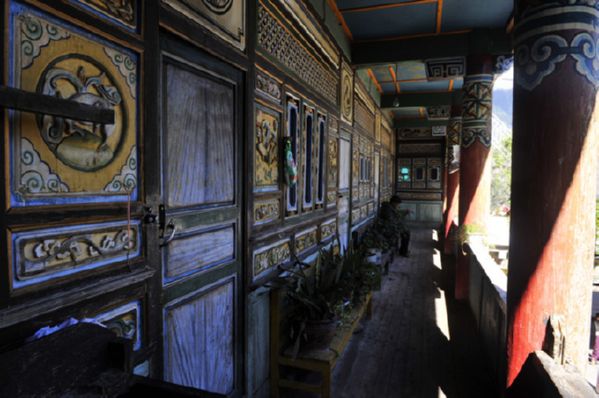
There was even a church in Lhasa, which was built by Jesuit Father Ippolito Desideri, and was a major source of understanding of the Tibetan culture for western scholars. Used by some of the Tibetan monarchs, as well as by the lamas of the Karmapa School to counter the influence of the Gelugpa School on the local population, the Christian missionaries were expelled in 1745, at the insistence of the Gelugpa lamas.
Since the clashes between the Catholics and the Lamas often ended in violent conflict, with priests and followers being killed, the government of the Qing Dynasty stepped in. in their attempt to prevent the destabilization of the Qing rule in Tibet, the government moved many of the Tibetan Catholics and relocated them in the neighboring provinces of Sichuan and Yunnan.
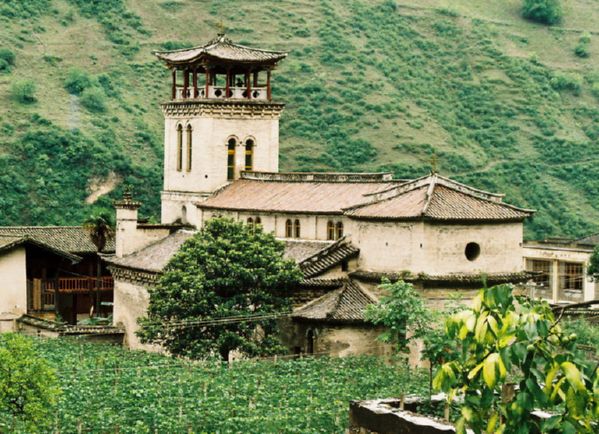
Cizhong Catholic church
Those that were resettled, still live on in their descendants in the Chinese provinces, with the largest Catholic congregation in the area being in Cizhong Village, in Yunnan’s Diqing Tibetan Autonomous Prefecture. And it is this resettlement of the Catholics to Cizhong that has made it the only place in China with an indigenous wine-making culture.
For more information of Tibet travel permit and Tibet tours, please visit our official website www.exploretibte.com
Recent Posts
The Perfect Tibet Tour Package
Journey to Tibet
Exploring Tibet
All Categories
- About Tibet
- book a Tibet tour
- Buddhism Practice
- Budget Tour
- China-Tibet Train
- Customized Tibet tour
- Historical Sites
- Hot Springs in Tibet
- News
- Photography in Tibet
- Tibet attraction
- Tibet Group Visa
- Tibet Motorcycle Tour
- Tibet Small Group Tours
- Tibet Tours and Tibetan Tour Guide
- Tibet Train
- Tibet Travel FAQs
- Tibet Travel Information
- Tibet Travel News
- Tibet Travel Permit Update
- Tibet Travel Prices Rises
- Tibet Trek
- Tibet Trekking Tour
- Tibet weather and climate
- Tibet Wildlife animals
- Tibet Winter Tour
- Tibetan Buddhism
- Tibetan Cultural Features
- Tibetan Culture and Poeple
- Tibetan Festivals
- What to see in Tibet



